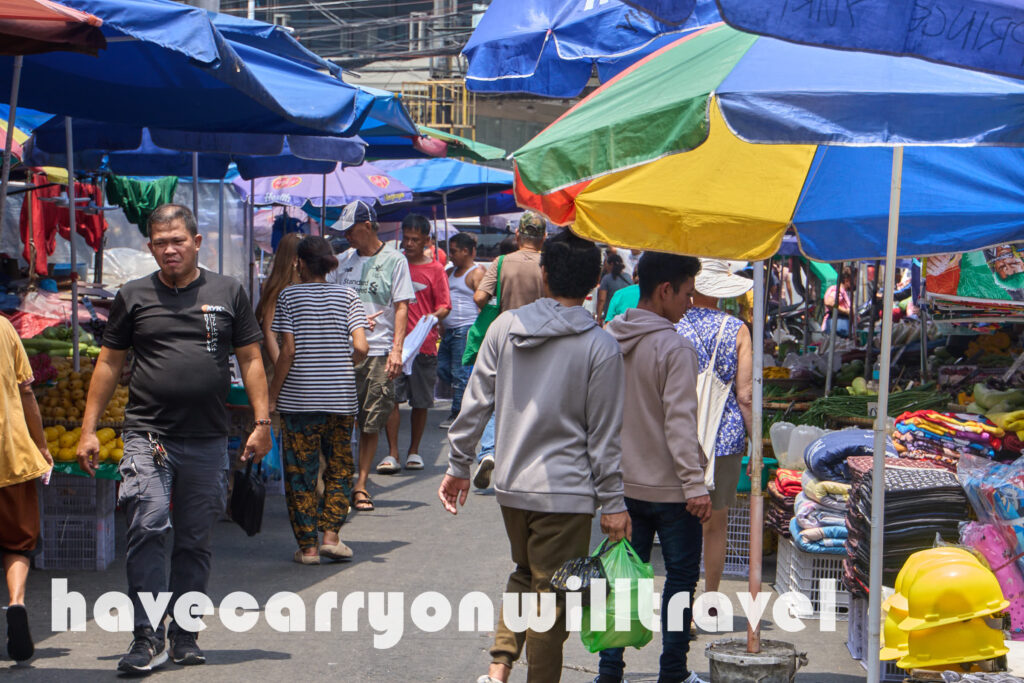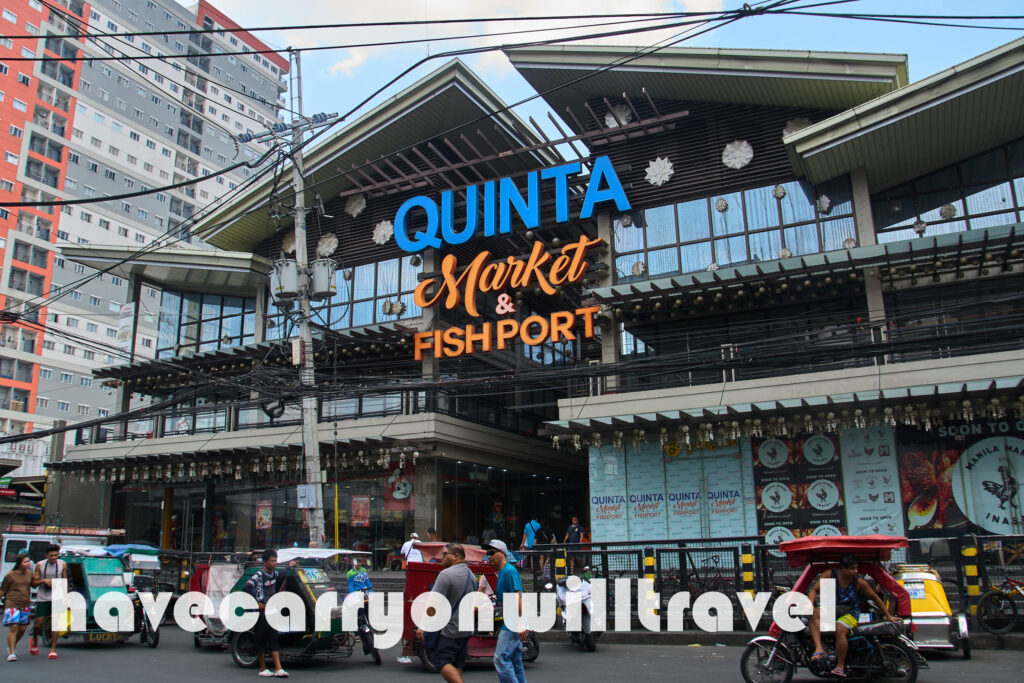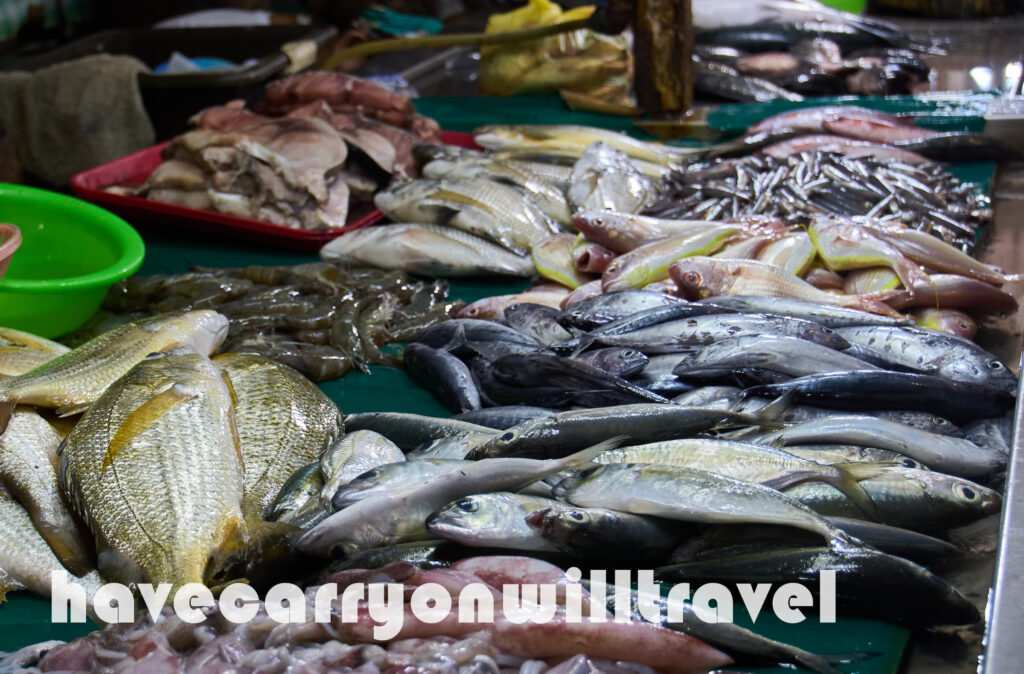Monday today, the museums and art galleries are closed. After years of travel I think we have finally learned that. The markets will indeed be in full swing and since we haven’t visited any of them in Manila, we thought we should. There are three somewhat different markets quite close together, we head toward the Quezon Bridge and the Quinta Market where we expect to find the sellers of meat and vegetables. Our route takes us along Evangelista Street. It is lined solid with shops and stalls. The shoppers are elbow to elbow. The Quinta Market itself is less crowded but the shop keepers are in full operation with their tables full of goods, be it fish, meat, fruit, or vegetables.
Adjacent to the Quinta building, under the Quezon Bridge is the Ilalim Ng Tulay market. Known as a handicraft market. The main product seems to be wicker; baskets, chairs, lampshades are all available.

Close by is the Rajah Sulimon Market. I’m not sure if it has any particular specialty but there are plenty of stalls lining the streets. This market didn’t have the same crowds as the ones on the west side of the bridge but it was still open for business and busy.
Walking the streets of Manila, I note there are a couple of odd businesses and not just a one off store, there are whole streets lined with them. The first is what looks to be the forging of fake documents. Do you want a university degree, maybe you need a drivers licence, or perhaps a passport from some other country. What ever you need, it seems you can have one made to spec here. The other occupation is cell phone repair. We have walked a couple of different street with literally hundreds of shops and kiosks offering to repair your broken cell or upgrade the glass with tempered glass or whatever needs to be done to make your phone better. We were in a 3 story ‘mall’ today entirely dedicated to cell phone repair and accessories. The inventory in every store is huge. I can only imagine that Filipinos change their phones on a weekly basis.

To get to and from the market we were back on the LRT. We’re getting around town like we knew what we were doing. We don’t see any tourists types on any of the local transportation. I don’t know if they rely on taxis or if they are all on some sort of tours but we have yet to see another white skinned person on a jeepney, a local bus, or the rapid transit in Manila. Taxis are expensive and frankly slow with Manila’s traffic and using local transport is a fraction of the cost and heaps more efficient. It took a bit of work to figure things out but after trying, it is extremely easy. Here everything is in English so even the ticket kiosks at the LRT are simple to navigate.

Riding the commuter train Debbie and I noted a few things. On our ½ hour ride we pass a university or a college every couple of minutes. And that is just the ones with signage facing the tracks and within visual distance. There are so many institutions of higher learning. In the long run, the Philippines will have a very well-educated population which bodes well for the future. The other aspect that becomes apparent while observing the environs as we pass by is how much religion plays a part in life here. We pass more churches than educational institutes. We can’t tell if the churches serve any particular branch of religion but if they fill up every Sunday it will take a significant number of people off the street for two hours in the morning.
Getting old is weird. In your head you are still as young as you want to be but your body has different ideas. In the mirror the daily change is so gradual you don’t notice you look old. In most Asian countries age is some sort of a badge of honour. I mentioned before we actually played the ‘old card’ and used a grocery store check out line that was devoid of a lineup. Reality hits hard when you get on the LRTrain and someone stands up taps you on the shoulder and offers the seat they had occupied. I have given up trying to say no, I just say thank you and sit down. The odd part is the person can be 40 years old or older but they still see us old people and are kind enough to give up their seat. Fat chance that would happen on a bus in Edmonton. But then again, I never ride a bus at home so for me personally it doesn’t really matter.

Another thing I see while staring out the windows is the accommodation in which people reside. I have noted during our touring around that the housing is somewhat meager. I am sure there are ‘fancy,’ larger, single family type houses somewhere, but we ran across very few. Most of the housing stock is constructed of scrap or repurposed building materials, the houses seem to be small with an outdoor cooking and eating area. In the cities the multi story buildings (and there are many many tall buildings) are older and in disrepair. In rural area the same type of housing is prevalent but these houses are surrounded by a larger plot of land rather than side by side with no space between the adjacent walls.

Besides using local transport, we walk. We walk until Debbie is about to collapse and then we head back to the hotel. We see a lot this way. We rub metaphorical elbows with the locals and maybe learn about how the place really ticks rather than seeing what the powers that be want us to see.
